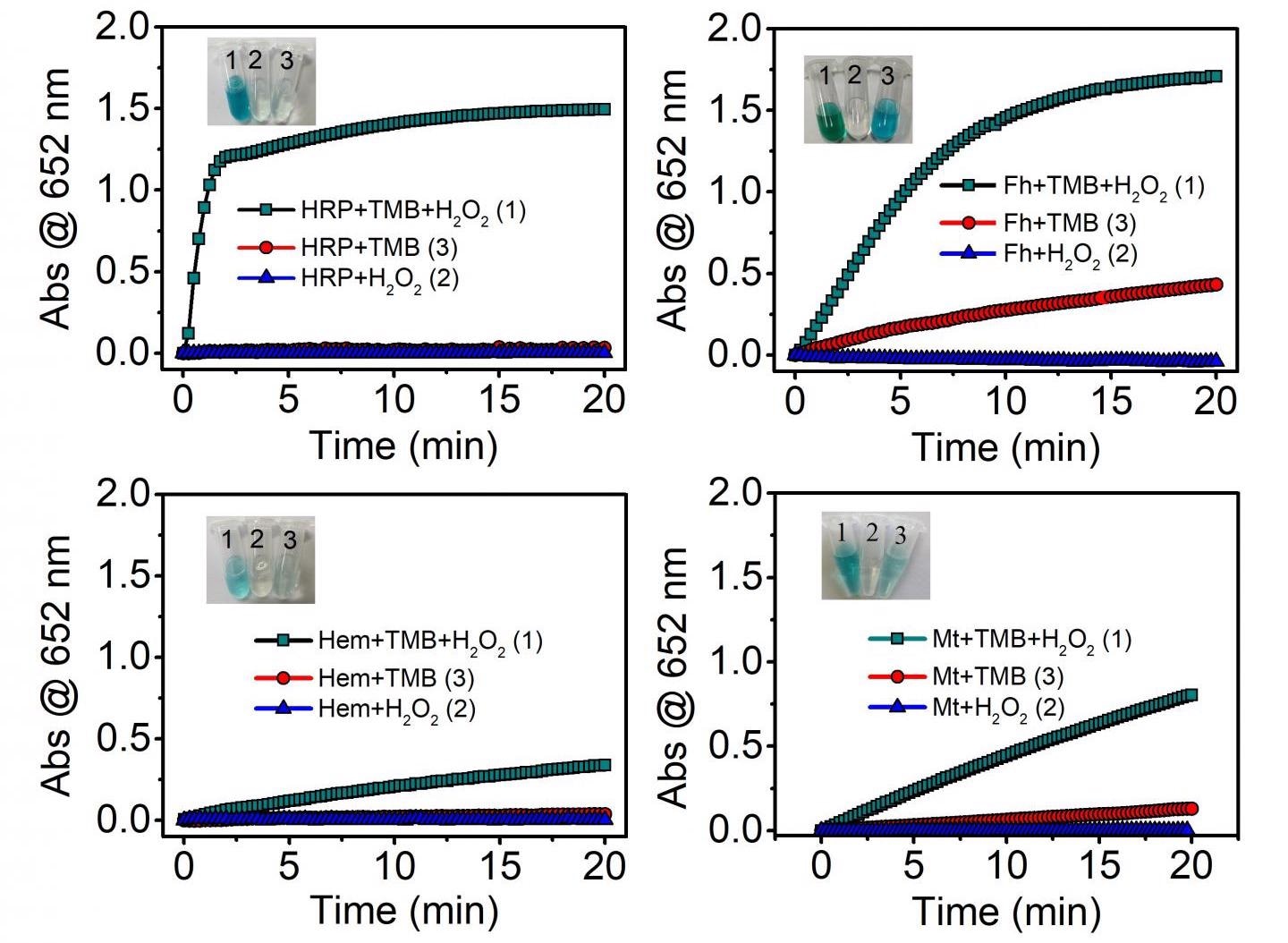Jun 9 2021
Throughout the world, the Earth system has thousands of terragrams (Tg) (1 Tg = 10 12 g) of mineral nanoparticles traveling around the planet every year.
 Colorimetric reaction catalyzed by the peroxidase-like activity of natural enzymes (HRP) and mineral nanozymes with substrates (TMB). HRP, horseradish peroxidase. TMB, 3,3',5,5'-tetramethylbenzidine. Fh, ferrihydrite. Hem, hematite. Mt, magnetite. Image Credit: ©Science China Press.
Colorimetric reaction catalyzed by the peroxidase-like activity of natural enzymes (HRP) and mineral nanozymes with substrates (TMB). HRP, horseradish peroxidase. TMB, 3,3',5,5'-tetramethylbenzidine. Fh, ferrihydrite. Hem, hematite. Mt, magnetite. Image Credit: ©Science China Press.
Such mineral nanoparticles are universally distributed across soils, waters, oceans and the atmosphere, in and/or on most living organisms and even inside proteins, like ferritin. In natural surroundings, mineral nanozymes can be generated by two pathways: “top-down” and “bottom-up” processes.
In particular, the human-promoted breakdown or weathering of bulk materials can directly result in nanomaterials (a top-down process), or nanomaterials can develop from precursors via crystallization, biological roles (a bottom-up process), or reaction.
Such mineral nanoparticles can have several enzyme-like properties, for example, superoxide dismutase, catalase, peroxidase, and oxidase, based on local surroundings. Iron-containing minerals, for example, magnetite, hematite, and ferrihydrite are abundant in Earth systems and have peroxidase-like activity. Among these iron (oxyhydr) oxides, ferrihydrite displayed the highest peroxidase-like activity, which can be attributed to its largest specific surface area and smallest particle size. Due to the presence of ferrous iron, magnetite has significantly high peroxidase-like activity.
When compared to natural enzymes, mineral nanozymes have many benefits, like increased stability, low cost, robustness to harsh surroundings and sustainable catalytic activity. Thanks to their larger specific surface area, wide bandgap, powerful catalytic activities and high ratios of surface atoms, mineral nanozymes play a crucial role in the biogeochemical cycles of elements in ecosystems.
Bacteria and fungi contribute around 120 Gt C to global biomass and 70 Gt carbon (C) (1 Gt = 10 9 t), respectively. Considering that fungal hyphae can collectively expand hundreds of kilometers in soils kg-1 in environments like the rhizosphere (that is, 200 to 800 km kg-1), and that over 94% of fungi and land plants form a symbiotic relationship, mineral nanozymes may have major implications in mineral carbon sequestration, nutrient cycling in the surface Earth system, microbial-mineral coevolution and mitigation of global climate changes.
In Earth systems, microorganisms that are functionally and taxonomically diverse are considered a huge source of hydrogen peroxides (H2O2) or superoxide (O2−). Such mineral nanozymes can control the levels of reactive oxygen species (ROS), for example, O2−, H2O2, and hydroxyl radicals (HO). By generating a powerful oxidative HO, the interaction between microorganisms and mineral nanozymes may play a crucial role in pushing the biogeochemical cycle of elements.
All of the investigations on mineral nanozymes are still in the laboratory stage and are not field studies.
Guang-Hui Yu, Scientist, School of Earth System Science, Tianjin University
“The catalytic activity of mineral nanozymes is mainly determined by the oxygen vacancies (OVs) on the mineral surface”, the scientists wrote in an article titled “Fungal Nanophase Particles Catalyze Iron Transformation for Oxidative Stress Removal and Iron Acquisition.”
“These oxygen vacancies are often occupied by hydroxyl groups on the mineral surface,” the researchers explained.
Since mineral nanozymes are capable of catalyzing H2O2 to create highly oxidizing HO, they have been widely employed in the environmental remediation field. When compared to natural enzymes, mineral nanozymes can decompose organic pollutants in a broader pH range. For instance, by decomposing H2O2, Fe3O4 nanoparticles could efficiently eliminate rhodamine B (RhB) in the pH range between 3.0 and 9.0.
“The effects of mineral nanozymes on microbial communities in the environment remain unclear,” wrote the two researchers, “the findings of mineral nanozymes may have revealed a previously unknown feedback route of microbe-mineral coevolution that could shed light on a number of long-standing questions, such as the origin and evolution of life by modulating ROS levels,” wrote the scientists.
Similarly, the two scholars highlighted in the study that the discovery of nanomaterials as novel enzyme mimetics has transformed the traditional concept that nanomaterials are chemically inert in Earth systems. The study was published in the journal Science China: Earth Sciences.
Considering the terragram (Tg)-level abundance of mineral nanoparticles in Earth systems, it is statistically highly probable for some of them, especially those of biotic origin, to act as mineral nanozymes to catalyze H2O2 and superoxide and support the biogeochemical cycles of oxygen and other elements.
The study was financially supported by the National Natural Science Foundation of China (Grant No. 41977271) and the National Key Basic Research Program of China (Grant No. 2020YFC1806803).
Journal Reference:
Chi, Z-L & Yu, G-H (2021) Nanozyme-mediated elemental biogeochemical cycling and environmental effects. Science China Earth Sciences. doi.org/10.1007/s11430-020-9756-5.